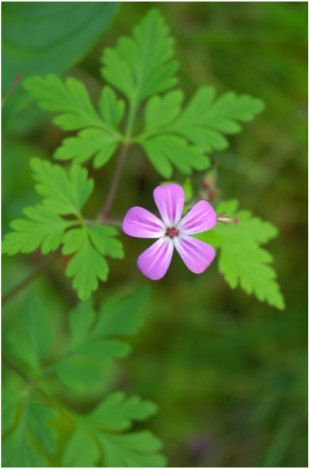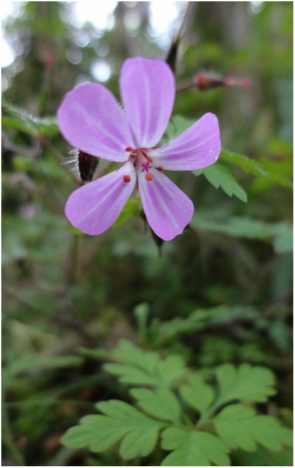Robert's geranium, Herb-Robert • Geranium robertianum
Identification
Robert's geranium is a 10-60 cm tall hairy annual which grows individually or grouped. It has branched stems which are topped with large leaves. The leaves are egg shaped to pentagonal in shape and composed of 3-5 divided or deeply lobed leaflets. The flowers are relatively small, five-petaled, and vary in colour from pink to reddish-purple, sometimes with white stripes. Robert's geranium has an unpleasant smell.
Habitat & Range
Robert's geranium is introduced from Eurasia and considered a weed. It inhabits clearings, meadows, grassy openings, and open forests. It is well established in southwest BC down to the Pacific coast to California, and is rare in the cooler climes of northern BC.
Interesting Info
This plant has a mysterious history with many possible namesakes. One theory is that is was named Robert's geranium in honour of St. Robert, who was born around the time the geranium flowers. Another possibility is that the name stuck after it was used in Germany to treat Ruprechts-plage, a disease named after Robert, Duke of Normandy. Click here for more information on etymology, folklore, and past medicinal uses.
Robert's geranium is a 10-60 cm tall hairy annual which grows individually or grouped. It has branched stems which are topped with large leaves. The leaves are egg shaped to pentagonal in shape and composed of 3-5 divided or deeply lobed leaflets. The flowers are relatively small, five-petaled, and vary in colour from pink to reddish-purple, sometimes with white stripes. Robert's geranium has an unpleasant smell.
Habitat & Range
Robert's geranium is introduced from Eurasia and considered a weed. It inhabits clearings, meadows, grassy openings, and open forests. It is well established in southwest BC down to the Pacific coast to California, and is rare in the cooler climes of northern BC.
Interesting Info
This plant has a mysterious history with many possible namesakes. One theory is that is was named Robert's geranium in honour of St. Robert, who was born around the time the geranium flowers. Another possibility is that the name stuck after it was used in Germany to treat Ruprechts-plage, a disease named after Robert, Duke of Normandy. Click here for more information on etymology, folklore, and past medicinal uses.
References
Pojar, J. and MacKinnon, A. (1994). Plants of Coastal British Columbia. Vancouver, BC: Lone Pine Publishing. P. 316.
Geranium robertianum L. In Klinkenberg, Brian. (Ed.). E-Flora BC: Electronic Atlas of the Plants of British Columbia. Lab for Advanced Spatial Analysis, Department of Geography, University of British Columbia, Vancouver. Accessed 28/11/2014.
Authors and editors of page
Paige Whitehead, Kelly Fretwell, and Brian Starzomski (2014).
Pojar, J. and MacKinnon, A. (1994). Plants of Coastal British Columbia. Vancouver, BC: Lone Pine Publishing. P. 316.
Geranium robertianum L. In Klinkenberg, Brian. (Ed.). E-Flora BC: Electronic Atlas of the Plants of British Columbia. Lab for Advanced Spatial Analysis, Department of Geography, University of British Columbia, Vancouver. Accessed 28/11/2014.
Authors and editors of page
Paige Whitehead, Kelly Fretwell, and Brian Starzomski (2014).





